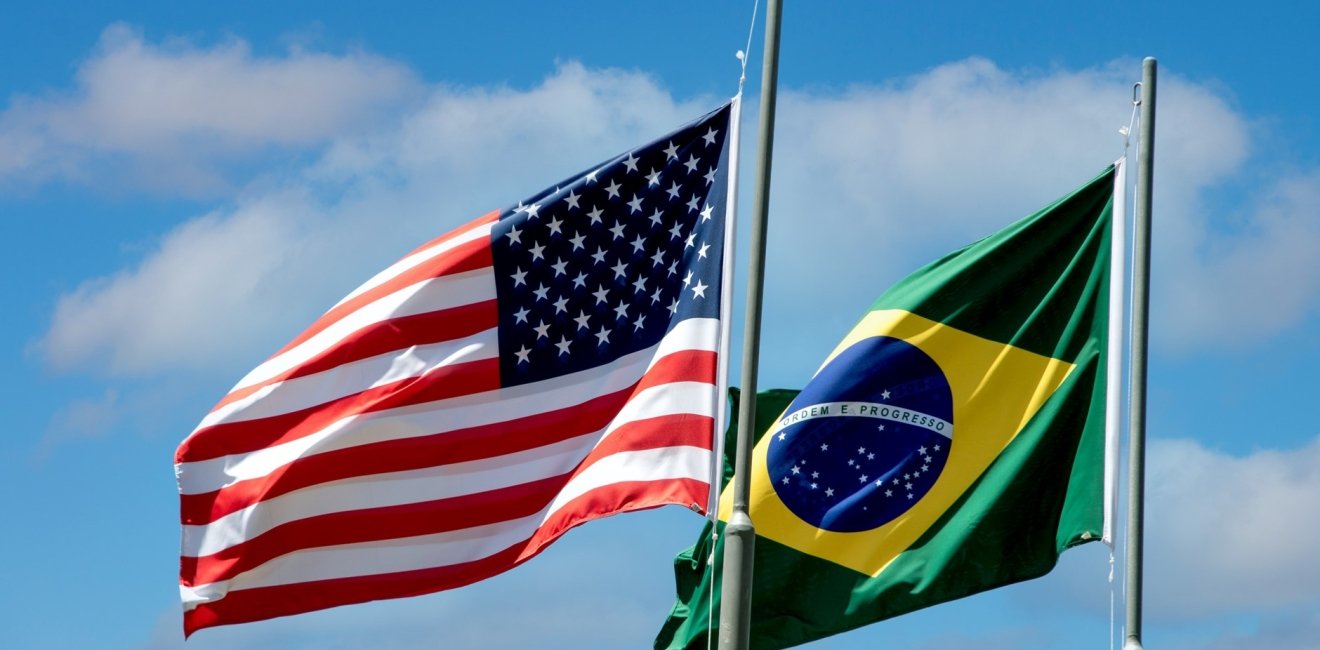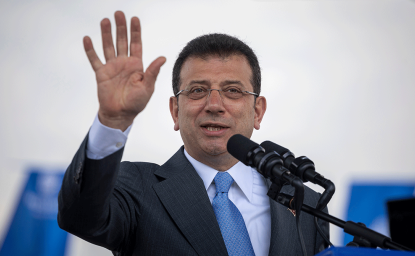Historical antecedents
After declaring its independence from Portugal in 1822, Brazil’s sovereignty was recognized by its neighbor Argentina, already independent from Spain, in 1823. By receiving Brazil’s representative in Washington DC in 1824, the United States became the second country to acknowledge Brazilian independence, although formal recognition did not come until the following year.
During the Brazilian First Republic (1889 to 1930), Brazil-U.S. relations constituted what the historian E. Bradford Burns termed the “unwritten alliance”. While mutual military aid and cooperation were not involved, active diplomatic engagements and well-developed commercial ties contributed to a strong friendship between the two hemispheric giants. The Brazilian position was shaped by the Baron of Rio Branco, Brazil’s Foreign Minister from 1902 to 1912, who recognized that the world order dominated by European states was shifting and that the United States was an increasingly influential rising power and market for Brazilian exports.
Over the past century, the two hemispheric powers have experienced periods of both approximation and distance, depending on the period and the policy issue. However, in the words of the scholar Monica Hirst, “the shared American identity, added to the attributes of power of both nations – territory, population and the size of the economy – have always constituted factors of attraction for one and the other.”[i]
Opportunities of the moment
The current geopolitical, commercial, economic, cultural, migratory, environmental, public health and global security significance of Brazil to the United States is self-evident. Brazil’s population is the seventh largest in the world with over 203 million inhabitants, and its labor force is well over 100 million. Under the third Lula administration, Brazil has rebounded in economic growth and now represents the world’s ninth-largest GDP. Economic growth in 2023 was 3% and is projected at 2.5% in 2024. This is higher than the average of less than 1.2% seen in the period 2019-2022.[ii] Even though China replaced the United States as Brazil’s number one trading partner around two decades ago, the U.S. remains a major player in foreign direct investment, and the commercial relationship between both nations is extensive and voluminous. Brazilian multinational companies have increased their investments and operations in the U.S. to a remarkable degree in recent years. Well over a million Brazilians reside in the U.S., including thousands working in the formal and informal sectors of the American economy.
As former U.S. Ambassador to Brazil Thomas Shannon has remarked, both nations have “dedicated themselves to building structures of political dialogue and cooperation that have largely kept the peace in the Western Hemisphere” and “in a world increasingly shaped by conflict and confrontation, this is a remarkable accomplishment.”[iii] Shannon characterizes “the combination of national purpose and global ambition” as unique to both countries, but adds, “to define it only in strategic terms would be to limit it. The partnership that defines the relationship is increasingly not only one of governments, but also of societies.”[iv] The historic and ongoing ties between the Brazilian and American labor movements, environmentalists, human rights advocates, academics, artists, musicians, and gender and racial equality activists, to cite only a few examples, support Shannon’s insightful and compelling contention.
The summit between Joe Biden and Lula on February 10th of last year in Washington, D.C. produced an aspirational blueprint aiming to maximize the relationship’s potential, as exemplified by the joint statement following the meeting. The document states that “strengthening democracy, promoting respect for human rights, and addressing the climate crisis remain at the center of their common agenda.”[v]
Both leaders expressed their determination to “fight hunger and poverty, enhance global food security, foster trade and remove barriers, promote economic cooperation, and strengthen international peace and security”, in addition to collaborating on the following: the Ukraine-Russia conflict, Brazil’s presidency of the G20, and UN Security Council reform, including the possibility of expanding the number of permanent seats for the nations of Africa and Latin America. The meeting hit all the right notes and was followed by a U.S. commitment of $500 million to the Amazon Fund, dedicated to sustainable development initiatives in Brazil.
On September 20, 2023, following the delivery of their speeches at the opening session of the UN General Assembly, Presidents Biden and Lula inaugurated the “Joint U.S.-Brazil Global Partnership for Workers’ Rights” in New York, with the participation of the International Labor Organization (ILO) Director General Gilbert Houngbo. Brazilian and U.S. union leaders were also present. The partnership signifies an unprecedented moment in the history of Brazil-U.S. relations since it is the first time that both countries have launched an ambitious labor rights initiative at the presidential level for workers in Brazil, the United States, and the rest of the world.
Given Lula’s globally recognized role in the construction of Brazil’s “new unionism”, which challenged the military dictatorship and the corporatist labor relations order of the late 1970s and early 1980s, along with Joe Biden arguably being the most pro-union president in American history, the partnership is powerfully symbolic. Although unprecedented and promising, some questions persist about the partnership’s next steps, necessary investments and financial commitments, and its durability.
Challenges and potential roadblocks
Given other global crises, including the Israel-Hamas war and the conflict between Ukraine and Russia, Washington does not seem to be paying much attention to the Brazil-U.S. relationship and its potential. Unfortunately, Brazil has once again been relegated to the role of a relatively low priority, a place it has usually occupied in the history of U.S. foreign policy.
A closer partnership between the two partners is also made more difficult by internal political dynamics in Brazil, including pressures from the Brazilian left. The latter has long been suspicious of U.S. intentions and hegemony, and for good reason, considering the active role of the United States in the coup d’etat of 1964, ushering in over twenty years of military dictatorship.
Washington has not been pleased with certain aspects of Lula’s active and independent diplomacy concerning, for example, the Ukraine-Russia conflict and China. Lula’s support for the recent South African initiative against Israel before the International Court of Justice, in which the South Africans argued that Israel’s actions in Gaza could constitute genocide, also soured the relationship, at least for a moment. [vi]
What should be done?
The United States and Brazil should make their current cooperation initiatives, including those outlined in the Biden-Lula joint statement of February 10, 2023, and the global labor partnership of September 20, 2023, as sustainable and durable as possible. If this is done, the cooperation could endure the political vagaries and shifts in the two countries. It will require diplomatic and bureaucratic focus, commitment, and alacrity on both sides.
The United States and Brazil should jointly assume leading roles and cooperate actively in global democracy promotion, especially given the nefarious coincidence (if not direct links) between the coup attempts of January 6, 2021, and January 8, 2023, in Washington DC and Brasília respectively, and the likely stress testing of democratic institutions in both countries in the immediate future.
The two largest powers in the Western Hemisphere should maximize all opportunities for collaboration in the Inter-American system, including in the Organization of American States (OAS), to advance a virtuous and results-oriented agenda in relation to the migration and refugee crises, drug enforcement, and security, economic growth and equality, social inclusion, environmental protection, labor and human rights, and democracy and the rule of law.
Washington should understand that Lula’s more active and independent diplomacy is not a threat to the American interests of global peace, democracy, and security. Lula’s credibility with much of the global south could redound to the benefit of the United States, and Washington should cultivate its relationship with Brazil to maximize that potential. For example, neither the Brazilian nor American economies can afford to decouple from China, and the Biden and Lula administrations should be actively discussing how both can work together to ensure that China’s global investment and operations comply with business, trade, and labor standards advocated by both Brazil and the United States. Brazil’s position and leadership in the BRICS, the G20, and other global fora, should not be seen as a threat to the U.S., but as a potential benefit and opportunity. Moreover, President Lula’s recommendations regarding the crisis in Venezuela following the July elections have been sensible and constructive for the most part, and they coincide in great part with President Biden’s most recent comments.
To maximize the potential of the Brazil-U.S. relationship, both countries need to create a formal and systematic framework at the highest level. Even with stark differences over the Free Trade Area of the Americas (FTAA) initiative and the war in Iraq, the Lula and George W. Bush administrations managed to convene the one and only inter-ministerial summit between both governments in June 2003. It was an unprecedented event, and it needs to be revisited at this critical juncture. As Ambassador Shannon has ably noted, the relationship needs to be cultivated and deepened not only between governmental leaders but between our two societies as well. The time has come for a renewed “unwritten alliance” between the two largest powers in the Americas.
[i] Monica Hirst, Understanding Brazil-United States Relations. Brasília: Alexandre de Gusmão Foundation, 2013, p. 29.
[ii] The economic data comes from “Crescimento médio do Brasil entre 2019 e 2022 deve ser de 1,14%, diz FMI” at InfoMoney, 10 October 2022, at: https://www.infomoney.com.br/economia/crescimento-medio-do-brasil-entre-2019-e-2022-deve-ser-de-114-diz-fmi/ accessed on 4 September 2024 and “Brazil GDP Growth Rate 1960-2024” at Macrotrends at: https://www.macrotrends.net/global-metrics/countries/BRA/brazil/gdp-growth-rate accessed on 4 September 2024.
[iii] Thomas Shannon, Uma Verdade Delicada Sobre Uma Velha Parceria [An Exquisite Truth About an Old Partnership], Revista Crusoé/DefesaNet, 1 January 2021, at: https://www.defesanet.com.br/tfbr/tfbr-thomas-shannon-a-delicada-verdade-sobre-uma-velha-parceria/.
[iv] Shannon, op. cit.
[v] White House Joint Statement – Biden-Lula – February 10, 2023.
[vi] See Daniel Buarque, “Com posicionamento sobre genocídio em Gaza, Brasil põe pé fora do muro” in Interesse Nacional January 25, 2024 at: https://interessenacional.com.br/edicoes-posts/daniel-buarque-com-posicionamento-sobre-genocidio-em-gaza-brasil-poe-pe-fora-do-muro/







